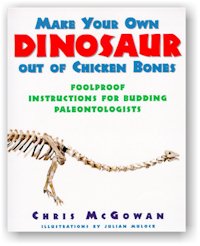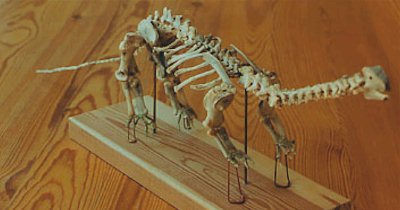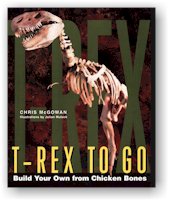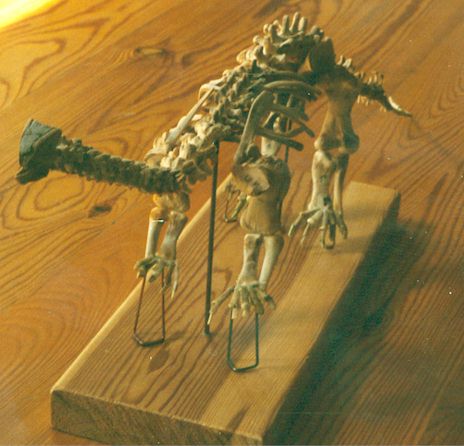Building scale dinosaur out of chicken bones
by Kai-Mikael Jää-Aro
As a change to the usual offerings I thought I’d tell about an advanced conversion project with no plastic contents whatsoever.
I’m somewhat interested in paleontology and when I recently heard of Chris McGowan’s book Make Your Own Dinosaur out of Chicken Bones I realised I had to have it.
McGowan is a paleontologist ”for real” but with an obviously great sense  of humour; he has written several popular books on paleontology. So, what is this book about? As the title says, you get a description of how to construct your own dinosaur skeleton out of chicken bones. To be precise, you have to use three chickens to make a dinosaur, but let’s start at the beginning.
of humour; he has written several popular books on paleontology. So, what is this book about? As the title says, you get a description of how to construct your own dinosaur skeleton out of chicken bones. To be precise, you have to use three chickens to make a dinosaur, but let’s start at the beginning.
Preparations
First you get yourself three chickens. I bought mine on different occasions and happened to get one which was quite a bit larger than the two others – it didn’t matter that much in practice, but I think it’s easier to get the pieces to fit if they are of comparable sizes.
Now you cook and eat the chickens, taking care not to damage the bones – of course the book contains three yummy recipes for chicken dinners that you can use. After this you have to remove all remaining pieces of meat from the bones, which you do by boiling the bones for a couple of hours and then attacking them with, say, an old toothbrush. One would expect it to be a fairly quick job to scrub a few chicken bones, but expect to spend a few hours on it. In addition it’s a fairly yucky job and I ended up having meat scraps all over the kitchen, so I had to spend some time cleaning up the kitchen as well. (She Who Must be Obeyed was quite pleased with the resulting spic and span kitchen and blessed any future attempts at chicken scrubbing.) I’ve wondered whether it would be possible to put the bones in an anthill and have the ants remove the meat from the bones, but didn’t have an anthill available to try the idea.
McGowan says to keep careful track of all bones and in particular the order in which vertebrae are detached from the spinal column, placing them on labelled paper plates. Being an Advanced ModellerTM I thought this didn’t apply to me, but believe me: it is much easier further on if all bones are labelled and all vertebrae strung on a string from the start.
Well, then you have to let the bones dry. In my case they dried for several months, while I was keeping myself busy with other projects, but one day I needed the baking plate I had spread the bones on (on some layers of kitchen tissue) – and decided to assemble the dinosaur.
Construction
What then followed was an intense session of mindless assembly – just adding the pieces as fast as the glue dried. I used ordinary white glue and it was quite pleasant to build something without having to worry how many brain cells got wasted in the effort. In addition I didn’t have to agonise over whether I had the exact shade of Dunkelseegrüngrau and whether there were better photoetched toenails than Eduard’s.
The dinosaur is constructed beginning with the spine, which is made from a thick metal wire (of a clothes hanger variety), bent to the right shape and with the vertebrae threaded onto it. You get to file the vertebrae a bit to make them a bit more dinosaur vertebraish. The legs and the feet are made by cutting and attaching suitable chicken leg bones. McGowan does not assume that you have more advanced tools than what can be found in the kitchen of an ordinary family, but a razor saw simplifies the work quite a bit in that you don’t have to boil the bones so soft that you can cut them with a nail cutter. I also used my Dremel to shape a few of the bones – but be careful if you do it, the bones are so porous that it’s easy to take off more than intended. Machining the bones also spreads a strange smell of burned chicken in the room…
Since chickens are normally sold decapitated (and the bird cranium wouldn’t fit anyway) the dinosaur’s head has to be made of left-over bone parts and some putty. (McGowan suggests plaster of Paris, but I used my standard Italeri putty instead.)
While you are fiddling around with the bones (you have to turn them the right way around, based on the bumps and muscle attachment points, so you have to study them carefully and compare with the drawings in the book) McGowan manages to teach you and impressive amount of comparative anatomy and information about how dinosaurs lived and how they are related to birds. Should you purchase the book, I strongly recommend reading the instructions carefully – they are well thought out and very complete. There is also a section with discussion topics and a bibliography with lots of nice books for further reading.
turn them the right way around, based on the bumps and muscle attachment points, so you have to study them carefully and compare with the drawings in the book) McGowan manages to teach you and impressive amount of comparative anatomy and information about how dinosaurs lived and how they are related to birds. Should you purchase the book, I strongly recommend reading the instructions carefully – they are well thought out and very complete. There is also a section with discussion topics and a bibliography with lots of nice books for further reading.
Finally you just have to mount the model on a base plate. Since I’m so bad at dry-fitting the feet didn’t quite reach the ground, but McGowan had foreseen this (!) and recommended the use of bent paper clips to keep the feet up. One could varnish the finished skeleton, but I didn’t see it as necessary – provided the bones were properly boiled and scrubbed there’s nothing left that could smell bad.
Other ideas
When proudly studying my finished work I came up with some ideas for additional projects:
As constructed the dinosaur just stands there, but it should be easy to create a little diorama where the dinosaur could be placed in a realistic pose – nibbling on a tree, playing with another dinosaur, or what have you.
As some fellow model builders seem to be of the opinion that I build in unnecessarily small scales, one could instead of chicken bones use turkey bones. It does take a somewhat larger effort to polish off three turkeys, but you could always have some friends over for a party and you can always keep the bones in the freezer until you have eaten three birds.
If you are affected by AMS (advanced modeller syndrome – Ed.)  you could spend some time studying real dinosaur skeletons and instead of this ”semi scale” model of an Apatosaurus-like sauropod create something more ”in scale”. (Though I guess Captain Birdseye Frozen Foods would not consider your complaint that their vertebrae are four scale inches off…)
you could spend some time studying real dinosaur skeletons and instead of this ”semi scale” model of an Apatosaurus-like sauropod create something more ”in scale”. (Though I guess Captain Birdseye Frozen Foods would not consider your complaint that their vertebrae are four scale inches off…)
I recently had a party for my friends and the dinosaur skeleton was an instant hit – little plastic planes are common, but a home-built dinosaur skeleton is fairly unique. My future plans are clear – a recently arrived copy of the follow-up volume T-Rex To Go is already on the building table…
References
- Chris McGowan: Make Your Own Dinosaur out of Chicken Bones: Foolproof Instructions for Budding Paleontologists, Harper-Collins, 1997
- Chris McGowan: T-Rex To Go; Build Your Own from Chicken Bones, Harper-Collins, 1999
This article was originally published in IPMS Stockholm Magazine in October 2001.

